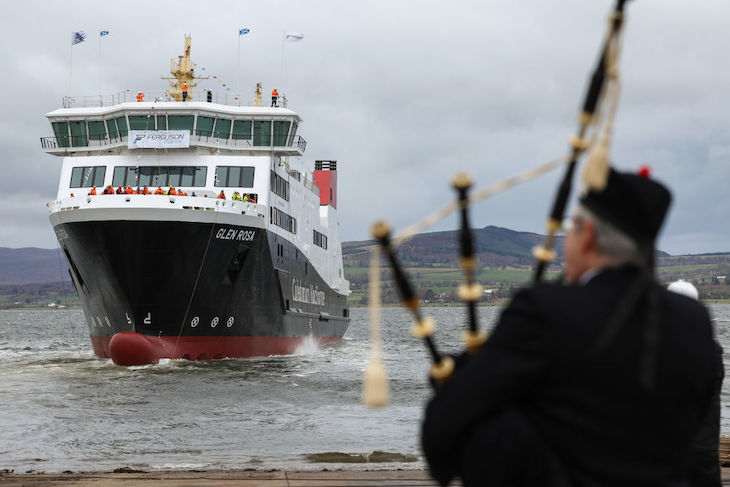Scotland’s SNP government would like nothing better than to be seen to have saved commercial shipbuilding on the Clyde. It likes the idea so much it has spent almost half a billion pounds of taxpayer money on the effort while trying to produce two new ferries for Scotland’s island communities. How ironic would it be if an opportunity emerged to finally create a commercially viable yard in Glasgow only for nationalist politics to get in the way of it coming to fruition? Yet that may well be what has happened in recent months.
If anyone is going to save commercial shipbuilding on the Clyde, it probably won’t be the SNP
The fatal moment appears to have been November of last year, when the SNP administration effectively kiboshed a plan from managers at Ferguson Marine, the nationalised shipyard at the centre of the ferries scandal, to make the yard long-term sustainable via a combination of new boat production and regular contract work for the UK military.
The yard’s then boss, the recently sacked David Tydeman, had asked for £25 million of investment in a new steel plating production line and other upgrades to raise productivity. The Scottish Government’s Economy Secretary, Neil Gray, rejected the request, insisting the yard should ‘refine’ its business plan before agreeing extra funding. Tydeman, who took the helm at Ferguson in February 2022, was subsequently relieved of his duties in late March.
His sacking came as something of a surprise. After previous costly failures, Tydeman had finally managed to get to grips with the production and design issues that had held up the building of the Glen Sannox and Glen Rosa, the two overdue, overbudget boats the yard had been struggling to build. At the time of his departure, the Glen Sannox was in the water conducting sea trials, while the Glen Rosa is in the final stages of completion.
Tydeman had also, for the first time, produced a serious plan for making the yard commercially sustainable. With the £25 million of new investment, he argued the yard would be in a strong position to build several new small vessels the Scottish government will soon commission as well as fulfil regular contract work on new ships for Britain’s navy.
UK defence contractor BAE has a shipbuilding yard in Govan. Insiders report that the yard is so busy its management is eager to utilise capacity elsewhere, so long as quality and productivity standards can be met. Tydeman appears to have recognised this opportunity early on. Not long after taking on the management of Ferguson he started sending a team of welders and platers to Govan on a day-rate basis. This then led to a formal pilot project for the state-owned business to produce three units for the Govan yard’s Type 26 frigate programme.
This went well, and there was every reason to believe ongoing military contract work alongside more precarious civilian full vessel construction could form the basis of steady future revenues. A formal five-year business plan was created, in line with recommendations from independent consultants brought in to produce a report (currently secret) on turning the yard into a commercially competitive operation.
The £25 million investment seemed a relatively small amount to create a business that would no longer be a drain on government finances and could finally be seen as a national asset.
There is an obvious incentive for nationalists to allow the yard to fail to become reliant on British defence procurement
However, timing was critical. For Ferguson to secure more contracts with BAE, and possibly also with Babcock’s defence shipping yard in Rosyth, and for the business to be in a position whereby it could competitively build smaller ferries, a new plating line had to quickly be ordered – some of the equipment has two-year lead times. One person close to the management team at the time says that when Neil Gray refused to give the go-ahead for purchase orders to be placed, BAE’s enthusiasm for Ferguson dissipated.
In a statement at Holyrood at the time, Gray said state aid rules prevented him giving a commitment on the new funding. He told MSPs the government’s ‘independent due diligence’ on the request had concluded it would not meet a ‘key legal requirement’. However, state aid rules only potentially apply to any contract for the small ferries the Scottish Government plans to order. Upgraded facilities are needed regardless – at least if the goal really is to create a commercially sustainable yard.
But was that Gray’s goal? Politically it might be easier to keep the business afloat but uncompetitive to get beyond the next Holyrood election. There is also the possibility that nationalist ideology has gotten in the way of pragmatic commercial considerations. Had Tydeman’s plan come to fruition it would have tied the sustainability of Scottish commercial shipbuilding directly to Scotland remaining within the UK. There is an obvious political incentive for a Scottish nationalist administration to conveniently find a way for the yard to fail to become reliant on British defence procurement. What an irony it would be if what was meant to be a totem of the independence cause emerged under nationalist control as a symbol of being ‘better together’.
As with so many aspects of the SNP’s ferries fiasco, the ministerial decision-making from November might never fully and honestly be explained. What is clear is that there was an opportunity last year for the yard to have a shot at becoming a sustainable business. That opportunity seems to have been forfeited.
That said, Scotland now has a new first minister who is smarter than the last one and seemingly eager to tone down the nationalism. Will John Swinney’s government be pragmatic enough to invest to boost yard productivity and get the military contract work back online? I wouldn’t bet on it. A repeat of past mistakes seems more likely.
If anyone is going to save commercial shipbuilding on the Clyde, it probably won’t be an SNP government.








Comments